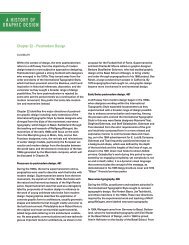Week 9 Graphic Design and the Industrial Revolution - A History of ...
Week 9 Graphic Design and the Industrial Revolution - A History of ...
Week 9 Graphic Design and the Industrial Revolution - A History of ...
- No tags were found...
You also want an ePaper? Increase the reach of your titles
YUMPU automatically turns print PDFs into web optimized ePapers that Google loves.
A HISTORY OFGRAPHIC DESIGNproduced <strong>the</strong> Swedish Song Quartett poster (c. 1867) <strong>and</strong> <strong>the</strong> graphics for <strong>the</strong> poster <strong>of</strong> Grover Clevel<strong>and</strong> <strong>and</strong> Thomas A.Hendricks in <strong>the</strong> 1884 presidential campaign. Hallmarks <strong>of</strong> his designs were meticulous <strong>and</strong> convincing tonal drawing<strong>and</strong> <strong>the</strong> integration <strong>of</strong> image <strong>and</strong> lettering into a unified design (Fig. 9-52).Louis Prang (1824–1909), page 164, a German immigrant to America whose work <strong>and</strong> influence were international in<strong>the</strong> Victorian Era. His knowledge <strong>of</strong> printing chemistry, color, business management, designing, engraving, <strong>and</strong> printingitself was <strong>of</strong> great value when he formed a chromolithography firm with Julius Mayer in 1856. In addition to creatingart reproductions <strong>and</strong> Civil War maps <strong>and</strong> scenes, he produced literally millions <strong>of</strong> album cards printed with images <strong>of</strong>wildflowers, butterflies, children, animals, <strong>and</strong> birds, called “scrap.” He has also been called <strong>the</strong> fa<strong>the</strong>r <strong>of</strong> <strong>the</strong> AmericanChristmas card for his pioneering work in holiday graphics. Unable to find high-quality, nontoxic art materials for children,he began to manufacture <strong>and</strong> distribute watercolor sets <strong>and</strong> crayons. Finding a complete lack <strong>of</strong> competent educationalmaterials for teaching industrial artists, fine artists, <strong>and</strong> children, he devoted tremendous energy to developing<strong>and</strong> publishing art instruction books (Fig. 9-54).Walter Crane (1845–1915), page 168, one <strong>of</strong> <strong>the</strong> earliest <strong>and</strong> most influential designers <strong>of</strong> children’s picture books.Apprenticed as a wood engraver as a teenager, he was twenty years old in 1865 when his Railroad Alphabet waspublished. A long series <strong>of</strong> his toy books broke with <strong>the</strong> traditions <strong>of</strong> printed material for children <strong>and</strong> sought only toentertain. He drew inspiration from <strong>the</strong> flat color <strong>and</strong> flowing contours <strong>of</strong> Japanese woodblock prints <strong>and</strong> was <strong>the</strong> firstto introduce <strong>the</strong>m into Western art (Fig. 9-65).R<strong>and</strong>olph Caldecott (1846–1886), page 168, a bank clerk who developed a passion for drawing <strong>and</strong> took evening lessonsin painting, sketching, <strong>and</strong> modeling. He possessed a unique sense <strong>of</strong> <strong>the</strong> absurd, <strong>and</strong> his ability to exaggerate movement<strong>and</strong> facial expressions <strong>of</strong> both people <strong>and</strong> animals brought his work to life. His humorous drawing style becamea prototype for children’s books <strong>and</strong> later, for animated films (Fig. 9-66).Kate Greenaway (1846–1901), page 170, Her expressions <strong>of</strong> <strong>the</strong> childhood experience captured <strong>the</strong> imagination <strong>of</strong> <strong>the</strong>Victorian era. As a poet <strong>and</strong> illustrator, she created a modest, small world <strong>of</strong> childhood happiness; as a book designer,she sometimes pushed her graceful sense <strong>of</strong> page layout to innovative levels. The clo<strong>the</strong>s she designed for her modelshad a major influence on children’s fashion design, <strong>and</strong> she became a renowned graphic artist whose books are still inprint (Fig. 9-67).James (1795–1869) <strong>and</strong> John (1797–1875) Harper, page 170, used modest savings—<strong>and</strong> <strong>the</strong>ir fa<strong>the</strong>r’s <strong>of</strong>fer to mortgage<strong>the</strong> family farm if necessary—to launch a New York printing firm called Harper Bro<strong>the</strong>rs in 1817.Wesley (1801–1870) <strong>and</strong> Fletcher (1807–1877) Harper, page 170, joined <strong>the</strong> Harper Bro<strong>the</strong>rs firm in 1823 <strong>and</strong> 1825, respectively.Eighteen-year-old Fletcher Harper became <strong>the</strong> firm’s editor when he became a partner.Thomas Nast (1840–1902), page 171, an artist-correspondent for Harper’s <strong>Week</strong>ly. Fletcher Harper hired him when hewas twenty-two to make battlefield sketches during <strong>the</strong> Civil War. The power <strong>of</strong> his work was such that President AbrahamLincoln called him “<strong>the</strong> best recruiting sergeant” <strong>and</strong> General Ulysses S. Grant declared that he had done asmuch as anyone to bring <strong>the</strong> conflict to a close. His deep social <strong>and</strong> political concerns led him to strip away detail <strong>and</strong>introduce symbols <strong>and</strong> labels for increased communicative effectiveness in his work. He has been called <strong>the</strong> fa<strong>the</strong>r <strong>of</strong>American political cartooning. The graphic symbols he popularized <strong>and</strong> focused include a number <strong>of</strong> important images:Santa Claus, John Bull (as a symbol for Engl<strong>and</strong>), <strong>the</strong> Democratic donkey, <strong>the</strong> Republican elephant, Uncle Sam, <strong>and</strong>Columbia (a symbolic female signifying democracy that became <strong>the</strong> prototype for <strong>the</strong> Statue <strong>of</strong> Liberty). His relentlesspolitical graphic attack <strong>of</strong> Tammany Hall culminated on election day in a double-page cartoon <strong>of</strong> <strong>the</strong> “Tammany tiger”loose in <strong>the</strong> Roman Colosseum devouring liberty, while Tweed, as <strong>the</strong> Roman emperor surrounded by his elected <strong>of</strong>ficials,presided over <strong>the</strong> slaughter (Figs. 9-71a <strong>and</strong> 9-71b).Charles Dana Gibson (1867–1944), page 171, His images <strong>of</strong> young women <strong>and</strong> square-jawed men established a canon<strong>of</strong> physical beauty in <strong>the</strong> mass media that endured for decades. His illustrations <strong>of</strong> women were dubbed <strong>the</strong> “GibsonGirls” (Fig. 9-72).Howard Pyle (1853–1911), page 172, His own work <strong>and</strong> remarkable gifts as a teacher made him <strong>the</strong> major force thatlaunched <strong>the</strong> period called <strong>the</strong> Golden Age <strong>of</strong> American Illustration. He published over 3,300 illustrations <strong>and</strong> twohundred texts ranging from simple children’s fables to his monumental, four-volume The Story <strong>of</strong> King Arthur <strong>and</strong> His
















